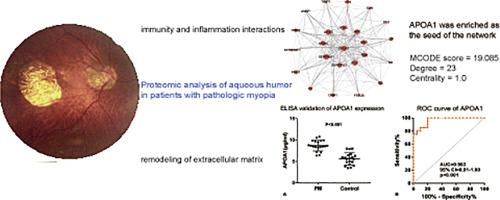Journal of Proteomics ( IF 2.8 ) Pub Date : 2020-12-26 , DOI: 10.1016/j.jprot.2020.104088 Min Xue 1 , Yifeng Ke 2 , Xinjun Ren 2 , Lei Zhou 3 , Juping Liu 2 , Xiaomin Zhang 2 , Xianfeng Shao 2 , Xiaorong Li 2

|
Complications from pathologic myopia (PM) are a major cause of visual impairment and blindness. However, an efficient clinical therapeutic strategy for PM is still lacking. The aim of this study was to quantitatively compare the proteomic profiles of aqueous humor between PM and non-PM cataract patients. Twenty aqueous humor samples from each group were analyzed with label-free quantitative proteomic analysis to identify the differentially expressed proteins for function enrichment analyses and protein-protein interaction network construction. Hub protein was validated with ELISA using an independent cohort consisting of 20 samples from each group and its receiver operating characteristic (ROC) curve analysis was conducted. A total of 583 proteins were identified and 101 proteins were found to be differentially expressed, including 63 up-regulated proteins and 38 down-regulated proteins. The bioinformatics analysis suggested that PM is closely associated with immunity and inflammation interactions, and remodeling of extracellular matrix. Apolipoprotein A-I (ApoA1) was enriched as the hub protein of the network with the highest score, degree and centrality. ROC analysis showed that ApoA1 could distinguish PM from controls with an area under the curve of 0.963 (p < 0.001). The findings could provide potential clues for further study on the molecular mechanisms and developing new treatments for PM, especially related to immunity and inflammation interactions. ApoA1 may be a potential key protein and therapeutic target in human PM.
Significance
It is important and urgent to discover the mechanisms of pathologic myopia (PM) to inhibit its progression. This study applied the quantitative proteomic analysis to study aqueous humor from patients with or without PM, aiming to discover dysregulated proteins related to PM. Our results suggested that those dysregulated proteins are closely associated with immunity and inflammation interactions, and remodeling of extracellular matrix. The findings from this study could provide potential clues for further research on the molecular mechanisms and developing new treatments for PM, especially related to immunity and inflammation. ApoA1 may be a potential key protein and therapeutic target in human PM.
中文翻译:

病理性近视患者房水的蛋白质组学分析
病理性近视(PM)引起的并发症是视力障碍和失明的主要原因。但是,仍缺乏有效的PM临床治疗策略。这项研究的目的是定量比较PM和非PM白内障患者房水的蛋白质组学特征。使用无标记定量蛋白质组分析法分析每组的20个房水样本,以鉴定差异表达的蛋白质,以进行功能富集分析和蛋白质-蛋白质相互作用网络的构建。集线器蛋白使用一组来自每个组的20个样品的独立队列进行ELISA验证,并进行了受体工作特征(ROC)曲线分析。总共鉴定出583种蛋白质,发现101种蛋白质差异表达,包括63个上调蛋白和38个下调蛋白。生物信息学分析表明,PM与免疫力和炎症相互作用以及细胞外基质的重塑密切相关。载脂蛋白AI(ApoA1)作为网络的枢纽蛋白得到了丰富,具有最高的得分,程度和中心性。ROC分析表明,ApoA1可以在0.963(p <0.001)。这些发现可能为进一步研究PM的分子机制和开发新的治疗方法提供潜在的线索,尤其是与免疫力和炎症相互作用有关的治疗方法。ApoA1可能是人类PM中潜在的关键蛋白和治疗靶标。
意义
发现病理性近视(PM)抑制其进展的机制是重要且紧迫的。这项研究应用定量蛋白质组学分析来研究患有或不患有PM的患者的房水,目的是发现与PM相关的蛋白失调。我们的结果表明,那些失调的蛋白质与免疫力和炎症相互作用以及细胞外基质的重塑密切相关。这项研究的发现可以为进一步研究PM的分子机制和开发新的治疗方法(尤其是与免疫力和炎症相关的方法)提供潜在的线索。ApoA1可能是人类PM中潜在的关键蛋白和治疗靶标。











































 京公网安备 11010802027423号
京公网安备 11010802027423号